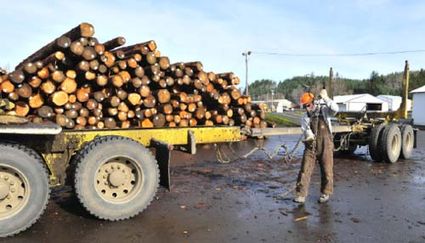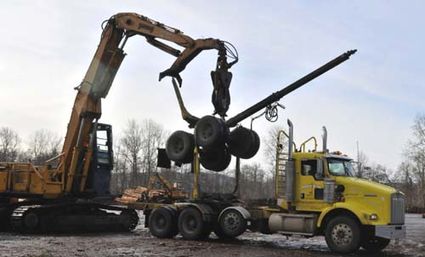Complexities of timber markets sway recovery
January 21, 2010

LOG TRUCK DRIVER: Tim Johnson prepares his trailer to leave the log sorting yard in Cathlamet. Johnson said the logging business is slow right now but he hopes it picks up soon. Photo by Stevan Morgain.
The Washington Department of Natural Resources says the worst may be over for beleaguered Northwest sawmills and timber companies.
In a report released this past September, the DNR said Wahkiakum’s timber sales hit bottom in the last quarter of 2009. The DNR is now saying the industry can look forward to slow but steady growth over the next two years.
The recovery however depends on a huge number of factors starting with employment and interest rates. Work Source of Washington says unemployment in the state is at 10 percent. The DNR says that number jumps when they factor in those who’ve given up looking for work, which pushes the jobless rate closer to 11 percent.
“Right now the timber market is up a little bit and there is reason to believe the recovery this time around will be very slow,” said County Commissioner Dan Cothren, who also works as a conslutant for Hancock Forest Products, “but I look for the real turn around to begin in 2011.”
Cothren indicated the consumption of wood products has started to inch up but it’s not likely to return to previous levels anytime soon. The DNR says another reason for the slow growth in the timber industry is that consumers are saving more to rebuild their wealth devastated by plunging housing prices and stock market prices.
The stockpiles of wood sitting in sorting yards mean companies aren’t likely to invest in equipment or hire people in a recessionary period.
The DNR report says that only the federal government is expanding, which will mean higher taxes on the lumber industry and a continued slowdown in the housing market.
“One good thing is the Canadians will be selling about 6 percent less wood in the U.S. market this year,” said Cothren.
The wood and forest products industries have paid a heavy price during the recent recession. Declining timber sales bottomed out in 2009 with logs selling at $130 per thousand board feet. The forest products industry estimates that since 2007 at least 35 mills have gone out of business here in the West.
“The whole deal is we’ve got to get people back to work,” said Cothren. “If we don’t get people back to work, they are not going to be building any houses.”
The lumber recession has also decimated lumber mills. The Green Mountain mill in Toutle closed and moved parts of its operation to Longview. The mill in Warrenton, Ore., was purchased and then shut down to modernize and improve efficiency.
For now both the DNR and the Western Forest Products Association say the key to the forest industry’s survival is its overseas market.
Because of state law, timber from state managed forests isn’t sold overseas.
However, the weak American dollar and Washington’s abundance of private, harvestable timber make Northwest wood products an attractive buy.
“What that does,” said Cotheren, “is that it diverts all the private timber into foreign markets and saves the DNR timber for domestic consumption.”
Cothren said what timber producers are counting on today are for the Korean and Chinese markets to take up the slack during the U.S. recession. He credits foreign timber markets for helping the Wahkiakum economy.

LOG LOADER: A log loader in the Cathlamet sorting yard sets the truck’s beam trailer in place after driver Tim Johnson dropped of a load of logs. Photo by Stevan Morgain.
“You know, if the Koreans and Chinese had not come in there wouldn’t have been a lot going on here at home,” he said.
“Early on, we were a zero percent exporter,” said Western Wood Manager Marty Wickland, “but right now I think probably except for a few lower grade items, we’re really 100 percent export, mainly to the Korean market.”
The lumber industry has a long way to go to get back to where it was in 2007, Cothren said, when it was producing over 300 million board feed annually.
“This is all going to hinge on getting people back to work so they can go out and buy homes.”
The DNR also says timber sales on the lands they manage have gone up as well. Based on their forecast for fiscal year 2010, the DNR reports they’ve already sold a little over 29 million board feet for the 2011 harvest season. That’s up 5 percent from one year ago.








Reader Comments(0)